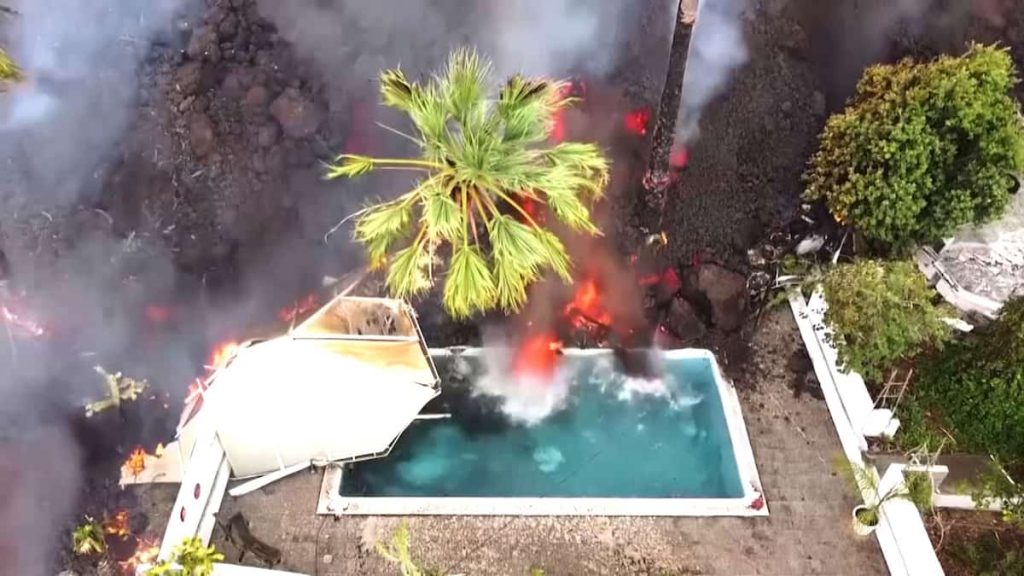Lava flows from Cumbre Vieja volcano, which erupted Sunday on the Spanish island of La Palma in the Spanish Canary Islands, continued on Wednesday to advance relentlessly toward the Atlantic Ocean under the gaze of desperate residents, doomed to note the massive devastation. .
• Read also: Volcanic eruption in the Canaries: lava descends slowly towards the sea, toxic gases fear
• Read also: Canaries: 100 homes destroyed, 5,500 people evacuated
According to the latest report presented by the European system of geospatial measurements Copernicus, 154 hectares of land and 320 buildings were destroyed by lava, including many homes that were hastily abandoned by residents.
Faced with this situation, firefighters engaged from Tuesday night to Wednesday in a desperate attempt to swerve into a gushing valley threatening lava flow homes in Todoc, one of the villages evacuated by the authorities and the last town before the coast, some of them. 2 km where the crow flies.
Firefighters on Twitter released pictures of construction machinery working at night in front of the rubble, hundreds of meters away from the incandescent lava flow.
A total of 6,100 people have been evacuated since the eruption began, which at this point has not resulted in any casualties. The authorities said that among them, 400 were tourists who were “removed from danger zones” and settled in Tenerife, on another island in the archipelago.
According to the president of the Canary Islands, Angel Victor Torres, the damage caused by the volcanic eruption – the first since 1971 on this island of nearly 85 thousand people – will exceed 400 million euros.
The lava in the ocean, which authorities fear due to the fumes of toxic gases and the predictions they could cause, was initially scheduled for Monday evening, but was delayed due to a slowing of the flow.
“Over the past hours,” David Calvo, of the Volcanic Institute of the Canary Islands (Involcan), explained, “the flow has slowed down so much,” that the junction between the lava and the ocean could intervene on Wednesday or Thursday.
The lava is now moving “at 300 meters per hour, maybe less, because it has reached a very flat area and is getting higher. There are areas already 15 meters high,” the volcanologist continued.
The regional government of the Canary Islands, which advised residents to cover their noses and mouths when they go out, has issued a decision “with a radius of exclusion of two nautical miles” about where the sea is expected to reach. Lava in the ocean.
It is necessary to be very careful with the fumes and gases that can be emitted at the time of the “lava entry into the sea,” insists David Calvo, which would be a confluence of water and lava similar to the “Battle of the Titans”.
“We had the Kilauea (volcano) experience three years ago in Hawaii, where 16 people were injured by one of these predictions,” recalls the volcanologist, whose “rhythm and strength of the rash will not diminish” in the next few days.
According to Involcan, which reported on Tuesday evening the return of seismic activity to the volcano, the Cumbre Vieja eruption could last “between 24 and 84 days,” with the key to significant emitting gas and smoke.
According to the institute, between 6000 and 11,500 tons of sulfur dioxide are spewed into the atmosphere every day.
The cloud, which has already reached the Moroccan coasts, was to extend to the Iberian Peninsula on Wednesday afternoon, before rising to the Balearic Islands and southern France, according to the forecasts of the Copernicus Program.
According to the same source, the sulfur dioxide cloud is supposed to cover the entire western Mediterranean and a large part of the Maghreb on Friday.

“Total coffee aficionado. Travel buff. Music ninja. Bacon nerd. Beeraholic.”







More Stories
$1,800 for a “ministerial meeting” with foie gras in the office of André Laforest: PLQ accuses CAQ of mismanagement of public funds
Manslaughter: Killed while eating raw food at a sushi restaurant
A pregnant woman violently headbutts three midwives